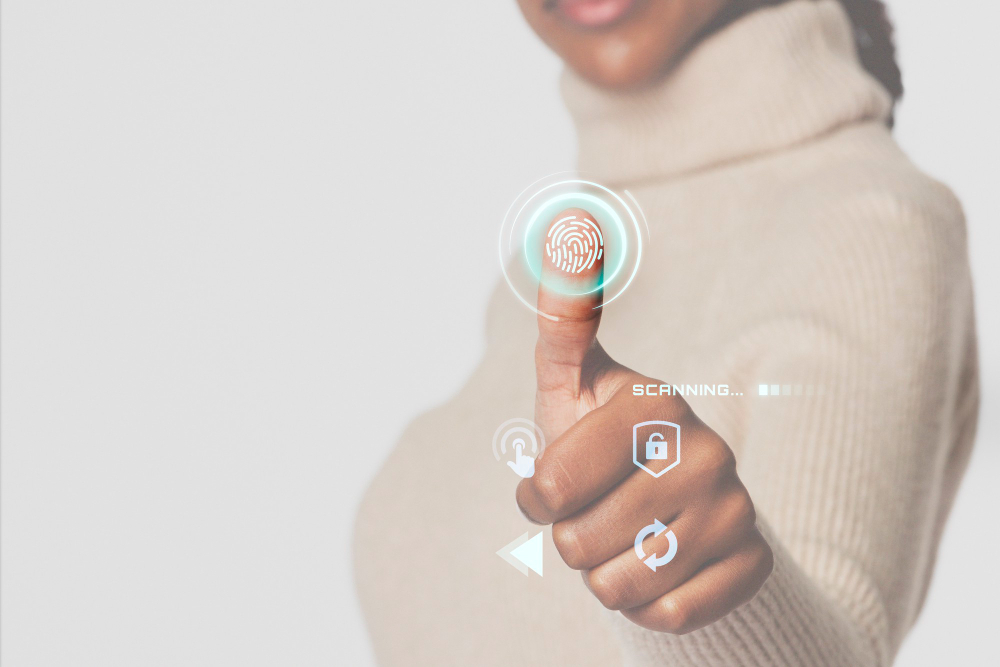To ensure security for any transaction or data and documents, people or organizations today use a type of verification measure called biometric authentication. Types of biometric authentication rely on the fact that certain biological or behavioral traits are difficult to replicate. Making it more secure than traditional authentication methods like passwords or PINs.
Examples of biometric authentication types include fingerprint recognition, facial recognition, iris recognition, voice recognition, and even typing patterns. When someone wants to access a secured system, they provide their biometric data. Which is then compared to a stored template to confirm their identity.
If the biometric data matches the stored template, the person is granted access; otherwise, access is denied. Biometric authentication is becoming increasingly popular as a security measure in various settings. Such as smartphones, laptops, and other electronic devices, as well as secure buildings and facilities.
Types of Biometric Authentication
As mentioned above, a few types of biometric authentication are available today. People can choose the one system more suitable for their needs. So here is the type of biometrics authentication examples for your information:
1. Fingerprint Recognition
This type of biometric authentication technology uses a person's unique fingerprints to verify their identity. This technology works by using a fingerprint scanner to capture an image of the user's fingerprint.
The scanner then analyzes the image and compares it to the fingerprints in a database. This is to determine if the user has the authorization to access the system or device. Fingerprint recognition is fast and convenient, allowing users to quickly and easily access their devices or systems. Without the need for passwords or other authentication methods.
However, some potential security concerns are associated with fingerprint recognition, including the possibility of fingerprint data being stolen or compromised. To mitigate these risks, many fingerprint recognition systems use advanced encryption. Also, other security measures to protect the integrity of the fingerprint data.
2. Facial Recognition
This type of biometric technology uses facial features to identify or verify an individual's identity. It is a popular form of biometric authentication used in a variety of settings, including law enforcement, border control, and commercial applications.
Facial recognition technology will analyze the facial features of an individual. Such as the distance between the eyes, nose shape, mouth, and even the face contours.
This technology creates a digital representation of a person’s face by using complex algorithms. Then it will compare the image to a database to determine if a match exists.
However, there are some potential security concerns about privacy and accuracy. Critics have raised concerns about the potential for facial recognition technology to be used for invasive purposes. Or, even produced false matches or identifications.
3. Iris Recognition
This biometric authentication technology uses unique patterns in an individual's iris to identify or verify their identity. Iris recognition is considered a form of biometric authentication that is highly accurate and secure. This has a range of potential applications, including access control, law enforcement, and border control.
This biometric authentication method works by capturing an image of the individual's iris using a specialized camera. The image is then analyzed using complex algorithms to create a digital template of the iris. Which is compared to a database to determine if a match exists.
However, this technology needs specialized hardware and software to capture and analyze iris images. Additionally, some individuals may have difficulty with the process of iris recognition. Particularly those with eye injuries or conditions that affect the appearance of the iris.
4. Voice Recognition
Biometric authentication using voice recognition is a technology that uses a person's unique voice patterns to identify or verify their identity.
Voice recognition technology works by capturing and analyzing various characteristics of an individual's voice, such as pitch, tone, and cadence. The technology then compares these characteristics to a database to determine if a match exists.
However, there are some potential limitations to voice recognition technology, including the need for specialized hardware and software to capture and analyze voice patterns. Additionally, external factors such as background noise or changes in the individual's voice can affect the accuracy of the technology.
5. Other Biometric Methods
Along with the types of biometric authentication mentioned above, some other biometric methods are also applicable today. Such as the following:
- Palm Recognition: This type of biometric authentication is commonly used in many places, such as offices, banks, and other locations. It has the same method as fingerprint authentication.
- Vein Recognition: Also called vascular biometric, works as iris and fingerprint authentication due to its uniqueness.
- Gait Recognition: This authentication uses people’s walking style and pace as a recognition method.
Which One is the Best?

The question about which types of biometric authentication are the best is somewhat a bit hard to answer. Each of the biometric authentication methods mentioned above has its strengths and weaknesses.
Not to mention that each person or organization has a different need and level of security. But there are some factors to consider in choosing the best method to use, such as below:
1. Accuracy
In general, iris recognition is considered to be one of the most accurate forms of biometric authentication. The unique patterns in the iris are highly complex and difficult to replicate, making it a very secure form of authentication.
Fingerprint recognition is also a highly accurate form of biometric authentication, with a low FAR and FRR. However, the accuracy of fingerprint recognition as well as facial, voice, and palm recognition can be affected by factors. Such as skin conditions, injuries, and age-related changes in the skin.
2. Security
Biometric authentication methods that use highly unique and complex biometric traits such as iris and fingerprint recognition are considered to be more secure. Compared to those that use less complex biometric traits such as facial or voice recognition.
However, it is important to note that fingerprints can be lifted or copied. In some cases, fingerprint recognition systems can be fooled by high-quality replicas or fake fingerprints. The same concern applied to palm recognition as well.
Facial recognition can be susceptible to spoofing attacks using high-quality images or videos, which can fool some facial recognition systems. While voice recognition can be susceptible to replay attacks, where a recording of an individual's voice is played back to fool the system.
3. Convenience
Technology sufficiently provides the system and equipment for any biometric authentication. But the most convenient and commonly used are fingerprint and palm authentication. For offices or any location that is not highly classified, these authentications are enough.
Any higher-level security locations, such as military, highly classified data or documents, or laboratories. Usually, they use the more detailed type of biometric authentication. Such as iris, facial, or any other authentication that needs more complicated equipment. Not too convenient for common people.
From all the information above about types of biometric authentication, one can understand the level of security that each type provides. This should help in the consideration of choosing the type that is most suitable for the type of location.
One alternative security method to biometric authentication is the use of one-time passwords (OTPs). OTPs are temporary, single-use passwords that provide an additional layer of security during the authentication process. Learn more about One-Time Passwords (OTPs) and revolutionize your authentication process. Level up your security now!
Get started with Fazpass today and experience the most secure and hassle-free OTP platform! Protect your business with the strongest password authentication method and say goodbye to complex integrations.










